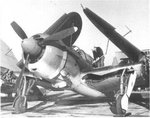parsifal
Colonel
great post mr Leonard....I will see if I can find any information about dive angles for the Firefly, though I think you are correct, I think it was more a steep glide angle rather than a divebombing angle.
I have seen footage showing Fireflies attacking up to angles of about 75 to 80 degrees angle of attack. Where does that place the Firefly. I do know it could effectively control its rate of descent using its combat flaps as defacto dive brakes. Its ability to slow the ratg of descent if required did improve its accuracy measuarably compared to other FBs
I have seen footage showing Fireflies attacking up to angles of about 75 to 80 degrees angle of attack. Where does that place the Firefly. I do know it could effectively control its rate of descent using its combat flaps as defacto dive brakes. Its ability to slow the ratg of descent if required did improve its accuracy measuarably compared to other FBs


